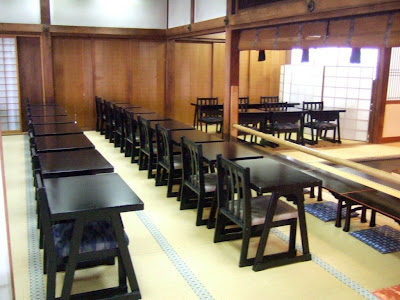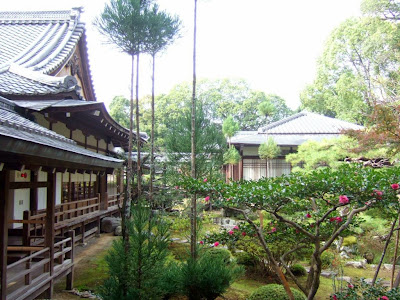
Temple Daikaku-ji is a large temple setting on 100 acres of plot located at the north west suburbs of Kyoto City. It was originally a detached palace of Emperor Saga (786-842) built around 800s. Emperor Saga enjoyed his stay in this calm area and treated it as a retreat villa. Thirty-four years later after his death in year 876, his daughter, empress Dowanger Seishi converted it into a temple. Since then, Daikaku-ji had been one of the highest ranked Shingon Buddhist Temple and played an important role in the history of Japan. The most significant historical events held at site was the 12th century peace conference that finally united the Southern and Northern Imperial courts of Japan after a 50 years civil wars.


The entire grounds of Daikaku-ji are a national historical site. The ceremonial Hall of Shikidai was moved from imperial palace in Edo Period (1615-1868). It contains gold foil pressed paper sliding panels with luxurious Kinpekiga paintings. The Hall was only opened to public for view on special occasions.



Daikaku-ji used to become a venue for filming historical dramas after it was featured in Tale of Genji, the first novel in Japanese Literature.


Daikaku-ji Temple Complex composed of several buildings linked by elevated wooden walkways made up of nightingale floors, which squeaked quietly when people walking on it, effectively giving signals to the hall occupants about the comers.



After Empress Seishi converted his father's retired home into a temple, she assigned her son Prince Gojaku as the first chief Priest. From then onwards, Head priests of Daikaku-ji were all from imperial family until Meiji period when the temples underwent restoration in 1868.


The skillfully pruned old pine trees are impressive. The long stretch building is the only structure looks new. It is the college for Buddhism studies.



Few thousands plants of various Chrysanthemum are on exhibition at the temple grounds every year in fall.


A view of its sutra transcript hall and display of an ancient sandal chair at Shikidai Entrance Hall.


Daikakuji Temple is a school of Sagagoryu School of Ikebana.


The beautiful Ikebana Japanese flower arrangement displayed outside the entrance Hall at left end, are impressive.








Chokushi-mon Gate in the past was meant for imperial messengers only. It was only opened when Emperors came. The front stone stage which is used as a performance stage for court music and dances, was the remaining of the original Godai-do main hall.


Plants of The fall flower Chrysanthemum were placed at every corner at site.



Chrysanthemum flower exhibition is usually held in fall. We were lucky to have come in the right time to become the guest of this great annual activity where thousand species of this autumn flowers were displayed at every corners in the temple ground.


Daikakuji Temple had been a retired home to few Emperors in 13th century. Shinden Hall presented by Emperor Go-mizunoo (1596-1680) in Edo period (1615-1868) was the former residential hall of imperial family.


Tatami room of Shinden Hall has fascinating Fusuma paintings on its gold foil panels. The series of long wooden verandas and corridors that linked to the Hall were all applied with Ugnisu-bari nightingale floor, that squeaked when people stepped on it.


The laid out route was well organized. From building to building, you just freely enjoy your excursion without worry about leaving behind any site.


The hall of Shoshin-den was an important national cultural asset. This was the place where a peace conference was held between the southern and northern courts of Japan after fifty years of civil wars. Shoshin-den was then the base of southern court.



Shoshin-den is one of the two noble buildings at the ground. It was connected by labyrinth-like wooden corridors. The 12 rooms of Shoshin-den that fully reflected the Shoin study alcove architecture of momoyama period (1573-1615) were set in a cozy garden.


Godai-do Hall was the main hall of Daikakuji Temple. It has a broad wooden terrace facing the man made huge Osawa-no-ike Pond. The Hall restored in late Edo period in 19th century also serves as one of the transcription hall.


The beautiful sight of foliage at Godai-do hall that enshrines with five images of Japanese Wisdom King Deities like Fudo Myoo.



The verandas of Godai-do Hall offer magnificent view of scenic Osawa pond especially in fall season.


Wooden corridors are winding around the perimeter of a dry garden shaded in burning red by its maple leaves.







The design of Temple grounds and set up of its buildings contains elements of an ancient imperial palace. The refined gardens and elegant halls were connected to each other by beautiful long wooden corridors.


The hall of Yasui-do that moved here from another Yasui Monzeki Temple during Meiji Period (1868-1912) was originated in mid Edo time (1615-1868). The shrine hall housed a life-sized image of Emperor Go-mizunoo who after being retired lived for another 51 years. He was considered one of the longest life Emperor in Japan history.


Buildings near the Octagonal Heart Sutra Pavilion include a little museum that opens only in spring and autumn to exhibit temple's treasures.



Octagonal Heart Sutra Pavilion houses one of the most important treasures in the temple, a copy of Buddhit Heart Sutra, hand written by Emperor Saga in early 9th century. The treasure was kept inside Pavilion Chokufu-Shingyo-den and is only exhibited once 60 years.



Emperor Saga was the son of Emperor Kanmu (737-806) who established Kyoto as a national capital in 794. When Saga enthroned in 809, the country was facing severe sufferings of feminines and plague. The Emperor seek advice from a priest Kukai (774-835)who was just certified as a Buddhist master in Shingon Sect of Buddhism and came back from Tang Empire of China (618-907). The Master suggested him to hand write the Heart Sutra. Emperor took his words and began to concentrate in writing the sutra, following one character with three bows ritual. He wrote it on a special dark blue paper by using tradition brush with gold powder. Soon the plague was overcame and ceased.



The ornament at the top of octagonal pavilion is awesome.


The Heart Sutra Pavilion situated at center of an inner dry garden, was linked with low ceilings corridors built with nightingale floors to aware invaders.


Reimei-den Hall was the main shrine of Tokyo Nichibutsuyi and being moved here in year 1958.


Reimei-den Hall enshrines an image of Amitabha Buddha and spiritual tablets of people who made contributions to the temple. The purpose of lacquering the entire building into vermillion bright color was said to defy the evil spirits.



The surrounding garden!



The Shrine of Mie-do that enshrined figures of Priest Daishi, Emperor Saga, Emperor Gouda, Prince Gojaku and many others, played an important role in the history of Daikaku-ji Temple. It was originally a banquet hall for coronation of Emperor Taisho. In year 1925, it was moved to the temple and renovated.


The river moat that surrounds the temple site.












A fascinated garden at the temple grounds outside the main buildings.




The elegant memorial brass stupa with donors names were erected at the external garden of temple ground.



A corner of pines


A brass bell tower can be viewed clearly over the moats and walls.



The roof of Chokushi-mon gate when looking from outside is particularly attractive.


Every where has artifacts including this old stone tori gate and the small ancient lamp .


The unique signboard of the main entrance gate .



Daikakuji Temple site is a very less touristic area, serene in nature but wealth in history. It certainly worth your time for a visit.


Some beautiful but unknown plants with colorful fruits and flowers.


The quiet and scenic road that leads to Daikakuji Temple.


The village where Daikakuji situated is tranquil and peaceful.


This 14 years old young student was my guide to Daikakuji Temple. I met him on the road from the railway station and he offered his help to bring me to the temple. He took me right to the entrance gate and tried to look for somebody to assist me before he turned back to his school, which according to his saying, its not too far from the site. I appreciated so much for his kindness and hospitality and wish him every success in his future, be well and happy always.


No comments:
Post a Comment